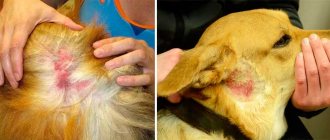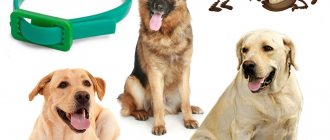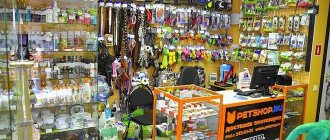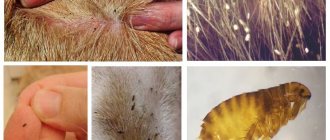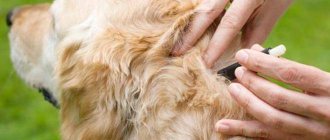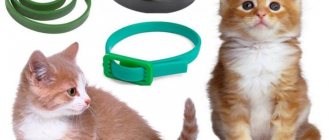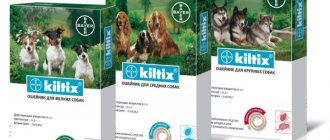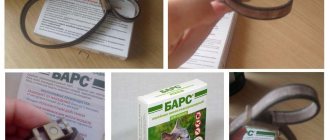Some dog owners are confident that if their pet does not go outside, then the risk of infection with fleas or other blood-sucking parasites is minimal, and sometimes not even possible. In fact, this is a misconception.
The owner himself can bring ticks or fleas into the apartment on his shoes or clothes. Veterinary experts strongly recommend regular preventive treatments against fleas, ticks and other parasites, not only during their active season, but throughout the year.
One of the effective methods of combating fleas and ticks in animals is special collars impregnated with substances that repel bloodsuckers.
How safety collars work
A flea collar is a flexible plastic band with a buckle to secure it around the animal's neck. The tape is impregnated with special substances that are activated upon contact with a dog. Due to heating, toxins from the collar spread through the coat, penetrate the skin and accumulate in the sebaceous glands. After a few days, the toxic substances will reach a sufficient concentration to destroy the bloodsuckers. The protective properties of the collar are maintained throughout the entire wearing time, so it is not recommended to remove it at night.
Benefits of flea and tick collars
Unlike sprays, drops and other anti-flea and anti-tick products, the collar has a number of advantages:
- is an accessible means of protection;
- convenient and easy to use;
- does not cause irritation or discomfort in the animal;
- destroys various types of parasites;
- has a long validity period;
- When used correctly, it is relatively safe for pets.
How long does it last?
Depending on the manufacturer, the collar is valid for 2–8 months. It is not recommended to use it longer than the period indicated on the package.
Collar Kiltix
The Kiltix collar is made of polyvinyl and is a ribbon of a certain length for different sizes of dogs: 66 cm for large dogs, 48 cm for medium dogs and 35 cm for small dogs.
"Kiltiks" uses drugs such as propoxur and flumethrin against ticks; they are gradually released from the collar and get onto the pet's fur and skin. Kiltix is well tolerated by dogs and does not cause irritation or side effects. The Kiltix collar can be dangerous for small animals (rats, hamsters, birds).
The Kiltix collar is indicated for protecting animals from ticks, fleas, lice, lice, mosquitoes and other insects. After printing, the collar is untwisted and put on the dog so that there is 1.5 cm of space between the Kiltix collar and the skin. After the collar is put on and fastened, you should cut off the excess piece so that the dog cannot reach it.
In the first few days, ticks and other parasites may cling to the dog, so you should refrain from walking in suspicious places. The collar will protect your pet from parasites for 7 months, provided that it is constantly worn.
Types of flea collars
There are several types of flea collars.
Chemical
A chemical collar is a collar that contains substances that destroy parasites. These are mainly acaricides and insecticides, sometimes repellents. Today they are in great demand among dog breeders. However, for some dogs it may be contraindicated as toxic.
Bio collars
Biological collars contain extracts of medicinal herbs and essential oils that repel ticks and fleas and also have a healing effect. Compared to chemical agents, they are safer for the animal, but quickly lose their protective properties.
Ultrasonic collars
The collar is equipped with a special device that creates ultrasonic impulses that repel parasites. This protective device is expensive and runs on batteries. According to dog owners, it is less effective than other types of collars, but is absolutely safe for the animal.
Homemade
A DIY collar will save money and protect your pet from exposure to chemicals.
To make a collar you will need:
- a strip of any natural dense fabric with a length equal to the circumference of the neck + 10 cm;
- 3 tbsp. spoons of garlic oil;
- 6 drops of essential oil of thyme, lavender, cedar;
- 3 tbsp. spoons of witch hazel extract.
Mix all components and soak the prepared strip in the resulting solution for 10 minutes. The collar should dry well. After 2 days it is ready to use. The collar is valid for 1 month.
Ultrasonic collar
The ultrasonic collar is suitable for protecting cats and dogs; it comes in the form of medallions that cling to the collar.
An ultrasonic collar repels parasites by emitting sound waves that are inaudible to the human ear, but highly irritating to parasites. A parasite caught under the influence of an ultrasonic trap immediately tries to move away from the source of the signal radiation.
An ultrasonic collar has a big advantage compared to collars that use chemicals, since it is completely safe for the health of cats, dogs, people and other animals.
Before purchasing such a device, it is better to read reviews from people who have already used the device on their pets. Many people claim that the device does not help at all against parasites living on animals.
How to choose the right flea and tick collar
There are certain criteria based on which you can choose a collar:
- The collar should not be too cheap. Poor quality ingredients can be harmful to your pet's health.
- Listen to the opinions of veterinarians and choose products from trusted manufacturers.
- Domestic and European brands will be a more reliable choice.
- The size of the collar should correspond to the circumference of the dog's neck, allowing for a small margin for comfortable wearing.
How to choose a collar for a puppy?
There is an age limit for using a collar for small puppies. It is not recommended to use it on an animal under 6 months old. Some brands of ecological products can be used starting from 2 months.
Depending on the weight and breed of the dog
Each dog breed is different from each other. Therefore, many companies produce antiparasitic products in sizes depending on the dog’s weight and breed. There are collars for small dog breeds, medium breeds and large breeds. Some companies offer collars that take into account the pet's weight - up to a certain weight or more.
Can it be used on pregnant and lactating dogs?
Flea collars should be used with caution on pregnant and lactating dogs. The manufacturer always indicates limitations and possible consequences, so read the instructions carefully.
Nursing dogs are advised to refrain from using the collar, as puppies can be poisoned by toxic substances if they come into contact with it. It is better to resort to other protective measures.
Terms of use
No matter how effective and safe an anti-parasitic collar is, it is possible to expect a positive result from its use only if it is used correctly. If this condition is not met, even the most expensive device from a manufacturer with the best reputation can cause harm to the pet’s health and will not provide adequate protection. So, how to use this product correctly.
To begin, remove the collar from the packaging and remove the plastic jumpers. After stretching the strap a little, place it around your pet's neck. At the same time, it is important to ensure that it does not fit too tightly - there should be a gap of one and a half centimeters between the body and the collar. Having adjusted the product to size, cut off the remaining tip or wrap it around your neck, threading it into a special pocket.
On a note! Not every collar can be cut. This is due to the fact that some will be saturated along the entire length with the amount of active substance necessary to protect the animal. It will always be written on the packaging whether the excess length can be removed!
As mentioned above, it is advisable to use several antiparasitic agents at once after consulting a veterinarian. In addition, you will always find information on whether any combination of such drugs is possible in the instructions for the purchased product.
When using a flea and tick collar during the first few days, you should avoid walking the dog in parks where there is a lot of vegetation, in the forest, and avoid shady areas - this is where ticks often wait for their victims. Plus, at the same time it is not recommended to carry out water procedures and not to take the animal outside in the rain and snow.
If you remove the collar for a while, you must put it in a sealed package and put it in a dry place, protected from direct sunlight, where the air temperature will not exceed +25°C and drop below 0°C.
And remember that this product is unable to prevent, let alone cure, parasitic diseases and the consequences of bites. It is only a precautionary measure that will help prevent infection.
Best Flea and Tick Collars for Dogs
Let's look at the rating of the best collars, which are in great demand among dog breeders.
"Fitodoc"
The biological type of the Fitodoc collar is harmless in its composition. Can be used without restrictions for any dogs, does not cause allergic reactions. The only drawback is the repellent effect on pests, so it is used in combination with other means.
"Foresto" odorless
It is an effective means of protection due to the content of active chemicals in it. It has no odor and does not cause allergies.
Available in two versions:
- up to 8 kg – 38 cm;
- over 8 kg – 70 cm.
Dog breeders speak well of this collar, as it not only repels fleas and ticks, but also destroys them. When bathing an animal, the protective equipment does not need to be removed.
Bayer "Kiltix"
The collar has a low concentration of harmful substances, therefore it eliminates side effects from use.
Produced by the German company Bayer, which provides 3 models for different dogs:
- for little ones – 35 cm;
- for medium-sized ones – 48 cm;
- for large ones – 65 cm.
Although the collar is waterproof, it is better to remove it before bathing your dog in order to extend the validity period, which is 7 months.
Rolf club "Rolf club 3D"
This model has three levels of safety and at the same time actively prevents bites from 9 types of parasites, repels midges and mosquitoes. It is a good choice for an owner who cares about the pet’s health. The collar does not cause allergies and does not interfere with the sense of smell. Available for different sizes of dogs, except puppies and sick four-legged dogs.
"SOS Flea & Tick Collar"
The peculiarity of this collar is that it affects a large group of parasites (fleas, lice, ticks, lice), as well as their larvae. The active substance spreads over the skin of the animal, but does not enter the blood. Controls pests until they bite.
The model is available in sizes 60 and 70 cm.
"Scalibor"
This is the type of model that is allowed to be used by pregnant, lactating dogs and puppies from 2 months of age. In rare cases, it causes allergies. It is resistant to moisture, but it is advisable to remove it before swimming. The active substance contained in the collar paralyzes insects, preventing them from biting. The protection period is 6 months.
The collar comes in different lengths:
- for small and medium breeds – 48 cm;
- for large breeds – 65 cm.
Hartz "Ultra Guard Flea & Tick Collar"
American has developed a collar specifically for puppies that are 6 weeks old. The product is absolutely safe and suitable for pregnant dogs. You don't have to take it off while swimming. The only limitation is incompatibility with other security tools.
Before use, the substance contained in the tape must be activated by shaking the collar.
"Ungezieferband"
The peculiarity of the collar is that it begins to act only 5 days after the start of use. Therefore, these days, the owner should exercise caution when walking his dog. Made from waterproof material.
The use of flea control is contraindicated in puppies under 6 months of age.
"Leopard"
The advantage of this model is its favorable purchase price and protection against many types of ticks. However, the product can cause a number of allergic reactions, including vomiting. Available for different sizes of dogs.
"Insectal Plus"
It is an inexpensive and at the same time effective means of protection. Actively fights parasites and prevents infection. There are practically no side effects. Available in different sizes for all categories of dogs.
Beaphar "Beaphar Ungezieferband"
The collar of this brand begins to have an effect on parasites five days after use. Allowed for use by dogs over 6 months of age. The exception is pregnant and lactating dogs.
The service life of the collar is up to 5 months.
4 paws
Suitable for all breeds of dogs, including pregnant, elderly and allergy-prone. Due to the content of essential oils, it eliminates ixodid ticks, lice, fleas. The validity period is 3 months.
Celandine
The collar contains pine fragrance and permethrin, which accumulates in the hair follicles, glands and epidermis without penetrating into the blood. Has a detrimental effect on fleas and ticks for 4 months. It is allowed to use other means of protection in parallel.
Doctor zoo
Comfortable, effective bio collar with less pronounced odor. Does not cause any discomfort to the animal. It is recommended to wear for 4 months, except for pregnant, lactating and weakened dogs.
Inspector
This collar is available for different breeds of dogs. It is a combined antiparasitic agent aimed at treating and preventing parasites. Has a slight odor. Not recommended for use with other products, may cause allergies in dogs.
Let's look at the pros and cons
Like any other antiparasitic product, a flea and tick collar for dogs has both advantages and disadvantages. First, let's look at the negative aspects.
Main disadvantages
The greatest number of shortcomings was noted in products impregnated with toxic substances. And they are bad not only because they can emit an unpleasant odor, but also because they have a harmful effect on the condition of the animal itself. In some cases, dogs may experience an allergic reaction, which is manifested by inflammation of the skin where the collar contacts the neck, as well as a general deterioration in health: vomiting, indigestion, lethargy and weakness. The dog will feel especially bad if there is an individual intolerance to active substances. By the way, the latter also applies to biological collars.
Important! In order to protect your pet from the dangerous consequences of allergies, during the first day of wearing the product you should constantly monitor the animal and examine it from time to time. If itching or rash appears, the collar must be removed immediately and selected from a different brand!
Another reason to consider such devices dangerous is the recommendation on the packaging, according to which it is undesirable to sleep in the same room with a dog wearing a flea collar.
If there are a lot of parasites on the animal’s body, then a collar alone will not be enough. In case of severe infection, it is recommended to first use special shampoos, drops or sprays.
Advantages
As for the positive aspects of using flea and tick collars for dogs, there are many more of them:
- firstly, they are a relatively inexpensive way to protect your four-legged friend from annoying parasites;
- secondly, anti-parasitic collars are very convenient, both for animals and for their owners - put them on once and you can not take them off until the expiration date, and in the meantime the product will protect the dog from fleas and ticks;
- thirdly, they are hygienic: there is no need to endure the extra bathing procedure, there is no need to wait for the fur to dry completely, as after drops, and the owner will not worry about his pet licking the drug or staining pieces of furniture;
- fourthly, just one device can have a fairly wide spectrum of action and protect the animal from fleas, ticks, lice eaters, and other pests;
- fifthly, modern anti-parasitic collars, including chemical ones, extremely rarely provoke the development of allergies.
On a note! Allergies in most cases occur when the owner, when purchasing a collar, does not take into account the weight, age or breed of his pet and chooses the wrong accessory!
Rules for using collars
When to put a flea collar on your dog
Before putting on a collar, veterinarians recommend completely getting rid of parasites. To do this, apply special drops to the withers or wash the animal with shampoo, and after 2 days put on a collar. .
Should I take off the collar at night?
If the dog lives indoors and has no symptoms of parasite infestation, the collar can be removed at night, allowing the dog to rest. In other cases, the collar must be worn 24 hours a day.
What to do if your dog is itching in a collar
If you notice your dog itching after wearing the collar for several hours, you should remove it to avoid allergic reactions and contact your veterinarian.
Can cats have a dog collar?
Cats should absolutely not use dog collars due to the high concentration of insecticides in them. Substances contained in dog protection products can be toxic to cats and lead to health problems.
Features of application
The use of anti-tick collars, leashes and keychains for dogs is generally a simple and moderately effective method of protection.
The collar is put on the dog, adjusted in size so that there is a gap of 1.0–1.5 cm between the animal’s neck and the collar, then the free end of the tape is passed through the clamp and the excess collar is cut off, leaving the end no more than 5 cm long.
The collar is used continuously during the parasite activity season. The collars begin to work 2-3 days after the start of use. In the first days of using the collar, ixodid ticks may attack and attach to the animal, but after 1–2 days the parasites spontaneously fall off. The effectiveness of using a collar depends on the condition and size of the dog's coat. Before putting on the collar, wash the dog, and after washing, put the collar only on dry hair. The period of protective action is up to 6 months.
Precautionary measures
There are certain precautions that must be followed:
- Considering that the collar begins to work after some time, you need to avoid walking until it is activated.
- Use the product with caution in combination with other products.
- Always read the instructions on the packaging.
- Avoid any hygiene procedures for a week after using the collar.
- Monitor for warning signs after starting use.
Purpose of the collar
Every year, tens of thousands of pets die from diseases caused by the bite of a tiny arachnid - a tick. Ticks are activated when it gets warm. At this time, long, lush grass grows, on which four-legged pets love to run. It is in the tall grass that ticks and other blood-sucking insects sit. They are just waiting for the right moment to cling to the fur of a curious animal.
Ticks do not dig in immediately and crawl through the dog’s fur for some time; by the way, at this time they pose a danger to people, since they can crawl from the dog to its owner. Having reached the skin of the animal, the ticks dig into it and begin to drink blood. At the same time, they secrete saliva containing anticoagulants to prevent the blood from clotting.
A sucked tick can increase in size tens of times and becomes noticeable on the dog’s body. However, if he was a carrier of any disease, removing him at this stage will not give anything - the infection has already occurred.
The use of dog collars reduces the risk of babesiosis, Lyme disease, borreliosis, ehrlichiosis and anaplasmosis due to ectoparasite bites.
Side effects
The instructions for using collars always indicate possible side effects:
- decreased visual and hearing acuity;
- allergic reactions;
- if the collar allows water to pass through, then swimming in it is prohibited;
- not all products eliminate parasite larvae;
- for long-haired breeds, collars may be ineffective;
- The effect of the collar does not apply to the back of the back, so some companies recommend combining it with other products.
Allergic reactions
Collar allergy in dogs manifests itself as redness of the skin, itching, and then hair loss. The pet may simply be in a lethargic state. This may indicate an incorrectly selected collar, or the animal’s intolerance to the substance with which the protective strap is impregnated.
When the first symptoms of an allergy appear, you need to remove the collar, wash the dog with shampoo and give it antihistamines.
Pros and cons of anti-parasite collars for cats and dogs
Like everything that exists, cat collars have their positive and negative aspects; below we will analyze whether it is worth using a collar or whether it is better to choose something else.
Pros of collars
- Easy to use - unlike other means of protection against parasites, you just need to put the collar on in the spring and you can forget about parasites for the entire warm season.
- Reliability – good collars guarantee protection for your pet for the entire period specified in the instructions.
- Cheap - since one collar lasts for 4-6 months, it will cost less than drops or aerosols that should be used to treat the animal every week.
- Practicality - using the collar does not cause difficulties and does not take time to process. Also, the collar will not stain furniture or carpet, unlike liquid protective equipment.
Cons of collars
- Efficiency - collars often lose their protective properties much earlier than the manufacturer indicates on the label. Also, cheap collars do a poor job of repelling parasites, and they move through the animal’s fur in an inhibited state.
- High toxicity - collars are impregnated with potent substances that destroy parasites. In most cases, they do not harm the animal, but there are cases when animals suffer serious skin injuries and even poisoning from insecticides in the collar.
- Chronic diseases - this information is kept silent by the collar manufacturers themselves, but if you regularly use a parasite collar, after a few years the animal may develop diseases that are caused by toxic substances in the collar. They do not lead to serious diseases, but diseases of the thyroid gland, liver and kidneys are also quite dangerous.
Be aware of the negative effects of parasite control and do not neglect your pet's health. If you use a collar or other means to repel parasites, carefully monitor the condition of your pet and at the first signs of poisoning or an allergic reaction, immediately contact a veterinary clinic.
Are there any contraindications or restrictions for wearing the product?
Collars are not used on sick or weakened animals, especially those suffering from infectious diseases. Also, the protective accessory should not be used for pregnant and lactating females, especially in the first half of pregnancy.
Anti-tick collars against fleas are used for dogs older than 8-12 weeks of age, depending on the manufacturer. Do not use cat collars on dogs - some of the ingredients that are safe for cats can be dangerous for dogs.
Side effects are observed in rare cases, with increased individual sensitivity of the animal to the active ingredients, individual reactions are possible (excessive salivation, lacrimation, muscle tremors, vomiting, skin irritation).
There are also manifestations of allergic reactions: itching and irritation in the neck area. In such cases, stop using the collar and consult a doctor for advice. Also, a negative reaction may occur when used simultaneously with other flea and tick protection products or other medications for the animal.
